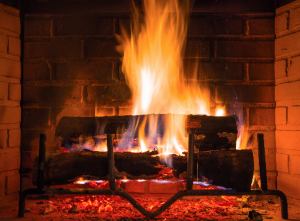
On a cold and wet winters day, a smoking chimney makes you think:
A “Oh what a lovelly fire inside that house!’
or
B “Oh, no, that fire is burning poorly, wasting money and polluting the enviroment.”
The correct answer is B
Did you know? If you are burning wood correctly on your woodburning stove you will have little to no smoke coming out of the chimney pot
Most of us think fires equal smoke. The truth is that, with correct lighting and burning you should have no smoke visible from your chimneys. The truth is. visible smoke is caused by Incomplete burning and these emissions contain contaminates and toxins, that will contribute to air pollution but also will condense on the inside of your chimney to produce a flammable creosote.
So how can we protect ourselves from these toxic invaders?
Here is a list of quick tips to help clear our air:
The basics:
Use dry wood. Wood needs to be well seasoned, and cut into 10-15cm wide pieces.Beter still invest in a moisture meter to ensure you wood is dry enough at 15%.
Start a great fire with generous amounts of paper (no glossy or coloured) and 5-10 pieces of super dry kindling, and not off cuts of painted or treated wood
Add two or three pieces of dry logs.
Attend the fire closely while it gets going to ensure proper air flow. Starting a fire requires lots of air!
Open air fires, remember that the amount of draw fireplaces require results in an overall heat LOSS. These fires are for beauty or “mood” only and should be kept small and very hot. Use small dry pieces of wood and burn them completely. Do not allow large smouldering logs to burn slowly and emit toxins into your home.
Wood stoves, wood appliances are designed to burn wood efficiently. If you can afford it, replacing an older stove with a new high efficiency stove will allow you to take advantage of new technology. New stoves increases secondary combustion of smoke within the stove, adding heat to your home and reducing smoke production. The initial investment in a new stove might appear to be expensive but the benefits of more heat from less logs with reduced pollution is worth it. If you think how much more efficient a modern car is compared to a car produced 30 years ago, the same is true with stoves!
No matter what stove you have these tips will help keep you safe from toxic smoke exhaust:
When starting a fire open the air intake completely and leave the door ajar to maximize air intake. The door may need to be open for up to 15 minutes to properly heat up the stove and chimney. Always attend closely during this time to keep watch for flying embers. For safety, remember to use a fire screen and ensure no combustibles are stored near the stove.
Once the stove is hot the door can be closed. If you have a glass front stove, check to ensure that the flames are bright orange/yellow/blue. Dull small flames indicate a lack of oxygen and incomplete combustion.
A thermometer on your chimney can also tell you if the fire is hot enough. A hot fire reduces polluting smoke and minimizes creosote build-up.
Minimize shutting down your fire. Limit air intake only to the point where the flame is still burning brightly and actively.
Allow the fire to burn down to large embers before building it up again. This will maximize efficiency and reduce that annoying “puff” of smoke that escapes when you open the door to reload.
When rebuilding the fire add a few pieces of kindling and a couple of pieces of wood. Open air intake completely and leave the door ajar for a few minutes to return the fire to a high temperature as soon as possible.
Never leave a smouldering fire, even overnight. While it may seem like a good idea or a time saver to have some embers in the stove when you go to relight, the damage to your health is simply not worth it.
If in doubt have a look at your chimney, if there is smoke coming out your fire is burning poorly.